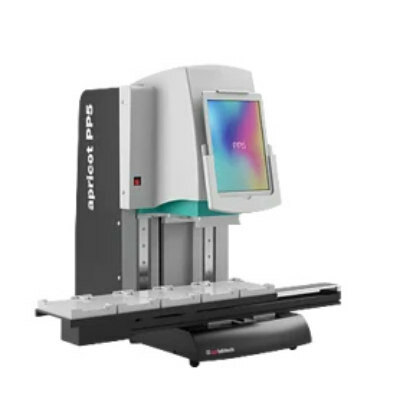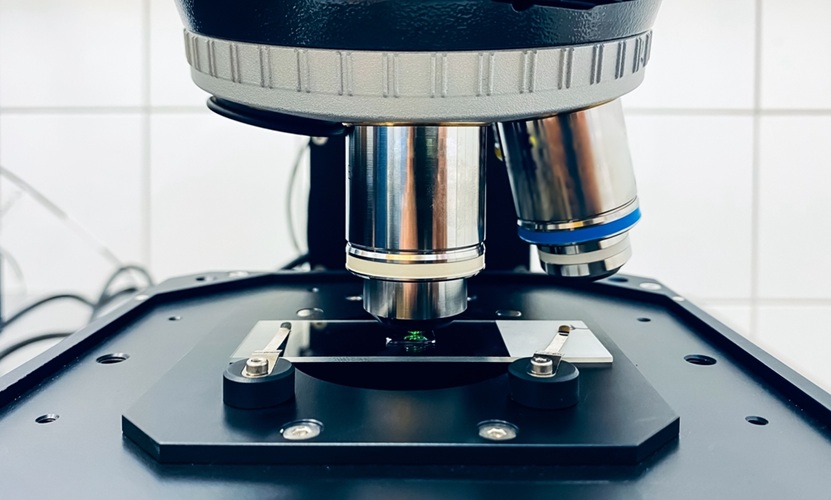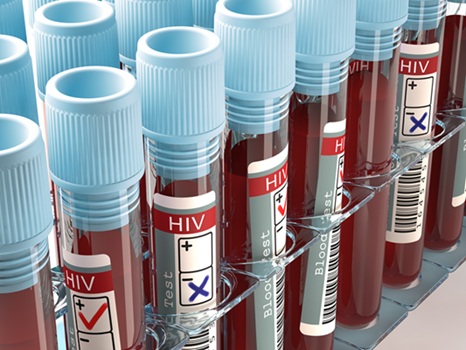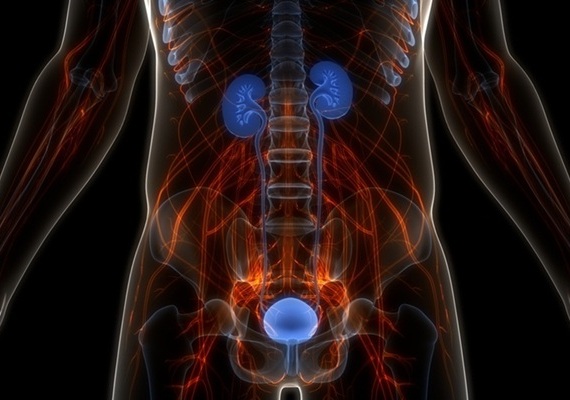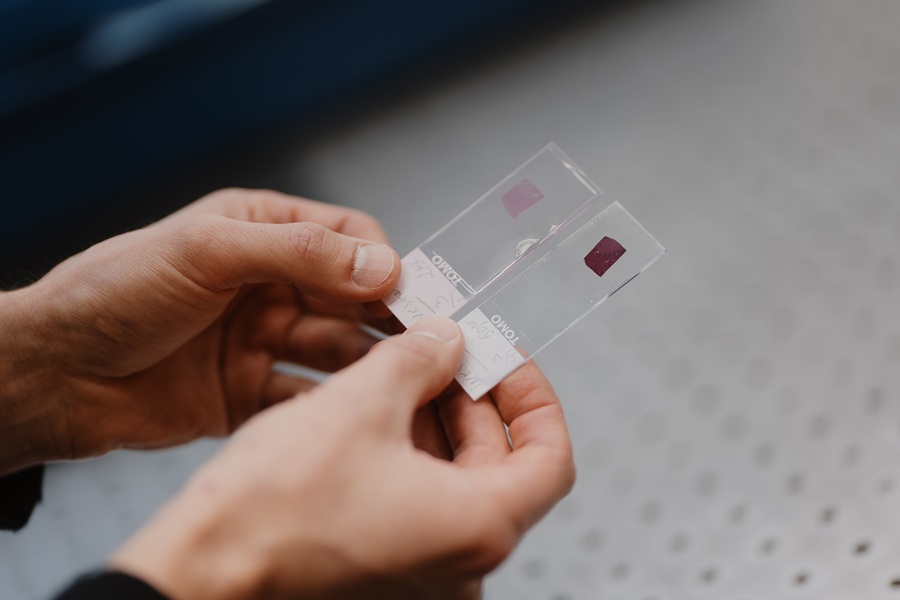Deeply Penetrating Nanoparticles Designed to Treat Osteoarthritis
|
By LabMedica International staff writers Posted on 12 Dec 2018 |
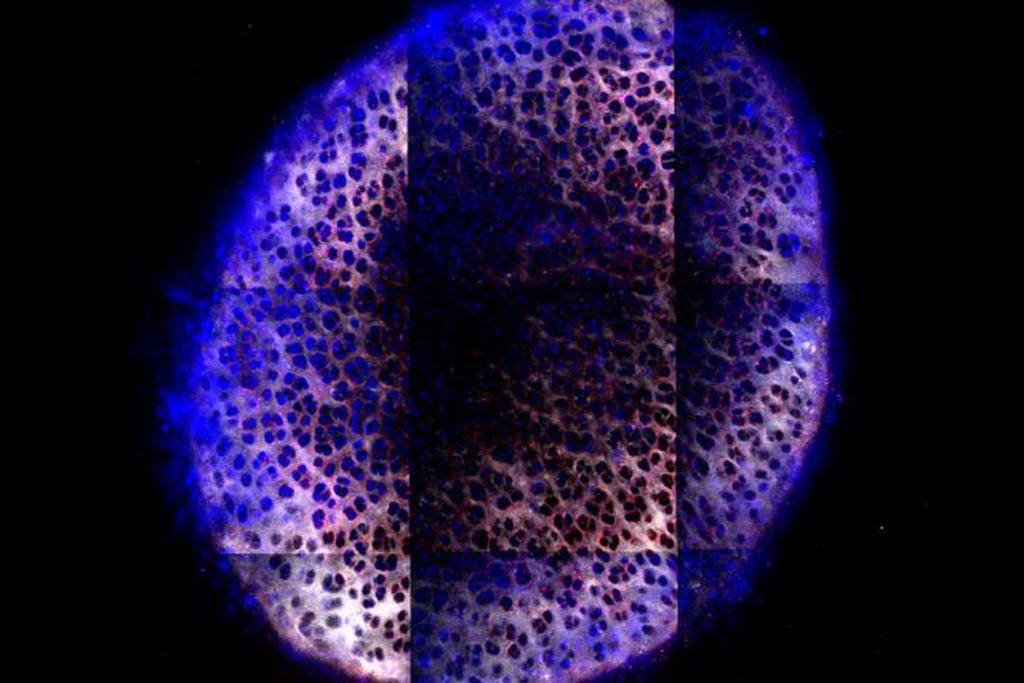
Image: Six days after treatment with IGF-1 carried by dendrimer nanoparticles (blue), the particles have penetrated through the cartilage of the knee joint (Photo courtesy of Brett Geiger and Jeff Wyckoff, Massachusetts Institute of Technology).
A novel nanoparticle-based drug transport system designed to treat osteoarthritis delivers the anabolic growth factor IGF-1 (insulin-like growth factor 1) directly to injured chondrocytes, which are located deep within a dense layer of cartilage tissue.
Osteoarthritis is a debilitating joint disease for which there are no disease-modifying therapies. Several drugs have failed clinical trials due to inefficient and inadequate delivery to target cells. Anabolic growth factors are one class of such drugs that could be disease-modifying if delivered directly to chondrocytes, which reside deep within dense, anionic cartilage tissue.
To overcome this biological barrier, investigators at the Massachusetts Institute of Technology (Cambridge, USA) conjugated IGF-1 to a cationic nanocarrier for targeted delivery to chondrocytes and retention within joint cartilage after direct intra-articular injection. IGF-1 is an anabolic growth factor that promotes chondrocyte survival, proliferation, and biosynthesis of cartilage matrix macromolecules. It also shows anti-inflammatory effects in cytokine-challenged cartilage tissue. Because of these properties, IGF-1 has garnered considerable interest as a potential disease-modifying drug.
The nanocarriers were prepared from repetitively branched molecules known as dendrimers. Poly(amidoamide), or PAMAM, dendrimers were utilized for their tertiary amine groups at the branching points within the dendrimer. Metal ions were introduced to an aqueous dendrimer solution and the metal ions formed a complex with the lone pair of electrons present at the tertiary amines.
The nanocarriers were end functionalized with variable molar ratios of poly(ethylene glycol) (PEG) to control surface charge. PEG provided reversible electrostatic interactions with anionic cartilage tissue to improve tissue binding, penetration, and residence time. From a small family of variably PEGylated dendrimers, an optimal formulation showing 70% uptake into cartilage tissue and 100% cell viability was selected.
The investigators reported in the November 28, 2018, online edition of the journal Science Translational Medicine that when conjugated to IGF-1, the dendrimer nanocarriers penetrated bovine cartilage of human thickness within two days and enhanced therapeutic IGF-1 joint residence time in rat knees by 10-fold for up to 30 days. In a surgical model of rat osteoarthritis, a single injection of dendrimer–IGF-1 rescued cartilage and bone more effectively than free IGF-1. Cartilage in injured joints treated with the nanoparticle-drug combination was far less damaged than cartilage in untreated joints or joints treated with IGF-1 alone. The joints also showed reductions in joint inflammation and bone spur formation.
"This is a way to get directly to the cells that are experiencing the damage, and introduce different kinds of therapeutics that might change their behavior," said senior author Dr. Paula Hammond, professor of chemical engineering at the Massachusetts Institute of Technology.
Related Links:
Massachusetts Institute of Technology
Osteoarthritis is a debilitating joint disease for which there are no disease-modifying therapies. Several drugs have failed clinical trials due to inefficient and inadequate delivery to target cells. Anabolic growth factors are one class of such drugs that could be disease-modifying if delivered directly to chondrocytes, which reside deep within dense, anionic cartilage tissue.
To overcome this biological barrier, investigators at the Massachusetts Institute of Technology (Cambridge, USA) conjugated IGF-1 to a cationic nanocarrier for targeted delivery to chondrocytes and retention within joint cartilage after direct intra-articular injection. IGF-1 is an anabolic growth factor that promotes chondrocyte survival, proliferation, and biosynthesis of cartilage matrix macromolecules. It also shows anti-inflammatory effects in cytokine-challenged cartilage tissue. Because of these properties, IGF-1 has garnered considerable interest as a potential disease-modifying drug.
The nanocarriers were prepared from repetitively branched molecules known as dendrimers. Poly(amidoamide), or PAMAM, dendrimers were utilized for their tertiary amine groups at the branching points within the dendrimer. Metal ions were introduced to an aqueous dendrimer solution and the metal ions formed a complex with the lone pair of electrons present at the tertiary amines.
The nanocarriers were end functionalized with variable molar ratios of poly(ethylene glycol) (PEG) to control surface charge. PEG provided reversible electrostatic interactions with anionic cartilage tissue to improve tissue binding, penetration, and residence time. From a small family of variably PEGylated dendrimers, an optimal formulation showing 70% uptake into cartilage tissue and 100% cell viability was selected.
The investigators reported in the November 28, 2018, online edition of the journal Science Translational Medicine that when conjugated to IGF-1, the dendrimer nanocarriers penetrated bovine cartilage of human thickness within two days and enhanced therapeutic IGF-1 joint residence time in rat knees by 10-fold for up to 30 days. In a surgical model of rat osteoarthritis, a single injection of dendrimer–IGF-1 rescued cartilage and bone more effectively than free IGF-1. Cartilage in injured joints treated with the nanoparticle-drug combination was far less damaged than cartilage in untreated joints or joints treated with IGF-1 alone. The joints also showed reductions in joint inflammation and bone spur formation.
"This is a way to get directly to the cells that are experiencing the damage, and introduce different kinds of therapeutics that might change their behavior," said senior author Dr. Paula Hammond, professor of chemical engineering at the Massachusetts Institute of Technology.
Related Links:
Massachusetts Institute of Technology
Latest BioResearch News
- Genome Analysis Predicts Likelihood of Neurodisability in Oxygen-Deprived Newborns
- Gene Panel Predicts Disease Progession for Patients with B-cell Lymphoma
- New Method Simplifies Preparation of Tumor Genomic DNA Libraries
- New Tool Developed for Diagnosis of Chronic HBV Infection
- Panel of Genetic Loci Accurately Predicts Risk of Developing Gout
- Disrupted TGFB Signaling Linked to Increased Cancer-Related Bacteria
- Gene Fusion Protein Proposed as Prostate Cancer Biomarker
- NIV Test to Diagnose and Monitor Vascular Complications in Diabetes
- Semen Exosome MicroRNA Proves Biomarker for Prostate Cancer
- Genetic Loci Link Plasma Lipid Levels to CVD Risk
- Newly Identified Gene Network Aids in Early Diagnosis of Autism Spectrum Disorder
- Link Confirmed between Living in Poverty and Developing Diseases
- Genomic Study Identifies Kidney Disease Loci in Type I Diabetes Patients
- Liquid Biopsy More Effective for Analyzing Tumor Drug Resistance Mutations
- New Liquid Biopsy Assay Reveals Host-Pathogen Interactions
- Method Developed for Enriching Trophoblast Population in Samples
Channels
Clinical Chemistry
view channel
Carbon Nanotubes Help Build Highly Accurate Sensors for Continuous Health Monitoring
Current sensors can measure various health indicators, such as blood glucose levels, in the body. However, there is a need to develop more accurate and sensitive sensor materials that can detect lower... Read more
Paper-Based Device Boosts HIV Test Accuracy from Dried Blood Samples
In regions where access to clinics for routine blood tests presents financial and logistical obstacles, HIV patients are increasingly able to collect and send a drop of blood using paper-based devices... Read moreMolecular Diagnostics
view channel
RNA-Based Blood Test Detects Preeclampsia Risk Months Before Symptoms
Preeclampsia remains a major cause of maternal morbidity and mortality, as well as preterm births. Despite current guidelines that aim to identify pregnant women at increased risk of preeclampsia using... Read more
First Of Its Kind Test Uses microRNAs to Predict Toxicity from Cancer Therapy
Many men with early-stage prostate cancer receive stereotactic body radiotherapy (SBRT), a highly precise form of radiation treatment that is completed in just five sessions. Compared to traditional radiation,... Read moreNovel Cell-Based Assay Provides Sensitive and Specific Autoantibody Detection in Demyelination
Anti-myelin-associated glycoprotein (MAG) antibodies serve as markers for an autoimmune demyelinating disorder that affects the peripheral nervous system, leading to sensory impairment. Anti-MAG-IgM antibodies... Read moreHematology
view channel
New Scoring System Predicts Risk of Developing Cancer from Common Blood Disorder
Clonal cytopenia of undetermined significance (CCUS) is a blood disorder commonly found in older adults, characterized by mutations in blood cells and a low blood count, but without any obvious cause or... Read more
Non-Invasive Prenatal Test for Fetal RhD Status Demonstrates 100% Accuracy
In the United States, approximately 15% of pregnant individuals are RhD-negative. However, in about 40% of these cases, the fetus is also RhD-negative, making the administration of RhoGAM unnecessary.... Read moreImmunology
view channel
Stem Cell Test Predicts Treatment Outcome for Patients with Platinum-Resistant Ovarian Cancer
Epithelial ovarian cancer frequently responds to chemotherapy initially, but eventually, the tumor develops resistance to the therapy, leading to regrowth. This resistance is partially due to the activation... Read more
Machine Learning-Enabled Blood Test Predicts Immunotherapy Response in Lymphoma Patients
Chimeric antigen receptor (CAR) T-cell therapy has emerged as one of the most promising recent developments in the treatment of blood cancers. However, over half of non-Hodgkin lymphoma (NHL) patients... Read moreMicrobiology
view channel
Handheld Device Deliver Low-Cost TB Results in Less Than One Hour
Tuberculosis (TB) remains the deadliest infectious disease globally, affecting an estimated 10 million people annually. In 2021, about 4.2 million TB cases went undiagnosed or unreported, mainly due to... Read more
New AI-Based Method Improves Diagnosis of Drug-Resistant Infections
Drug-resistant infections, particularly those caused by deadly bacteria like tuberculosis and staphylococcus, are rapidly emerging as a global health emergency. These infections are more difficult to treat,... Read more
Breakthrough Diagnostic Technology Identifies Bacterial Infections with Almost 100% Accuracy within Three Hours
Rapid and precise identification of pathogenic microbes in patient samples is essential for the effective treatment of acute infectious diseases, such as sepsis. The fluorescence in situ hybridization... Read morePathology
view channel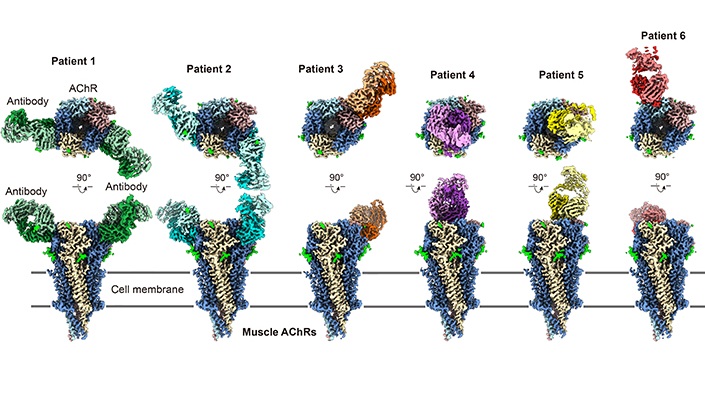
Advanced Imaging Reveals Mechanisms Causing Autoimmune Disease
Myasthenia gravis, an autoimmune disease, leads to muscle weakness that can affect a range of muscles, including those needed for basic actions like blinking, smiling, or moving. Researchers have long... Read more
AI Model Effectively Predicts Patient Outcomes in Common Lung Cancer Type
Lung adenocarcinoma, the most common form of non-small cell lung cancer (NSCLC), typically adopts one of six distinct growth patterns, often combining multiple patterns within a single tumor.... Read moreTechnology
view channel
Pain-On-A-Chip Microfluidic Device Determines Types of Chronic Pain from Blood Samples
Chronic pain is a widespread condition that remains difficult to manage, and existing clinical methods for its treatment rely largely on self-reporting, which can be subjective and especially problematic... Read more
Innovative, Label-Free Ratiometric Fluorosensor Enables More Sensitive Viral RNA Detection
Viruses present a major global health risk, as demonstrated by recent pandemics, making early detection and identification essential for preventing new outbreaks. While traditional detection methods are... Read moreIndustry
view channel
Cepheid and Oxford Nanopore Technologies Partner on Advancing Automated Sequencing-Based Solutions
Cepheid (Sunnyvale, CA, USA), a leading molecular diagnostics company, and Oxford Nanopore Technologies (Oxford, UK), the company behind a new generation of sequencing-based molecular analysis technologies,... Read more
Grifols and Tecan’s IBL Collaborate on Advanced Biomarker Panels
Grifols (Barcelona, Spain), one of the world’s leading producers of plasma-derived medicines and innovative diagnostic solutions, is expanding its offer in clinical diagnostics through a strategic partnership... Read more









